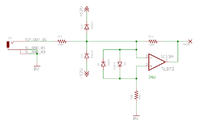juz_ad
Full Member level 2

I was given some advice last year on another forum about some basic, general purpose input protection methods for op amps. The schematic above shows what I ended up with and is based on a TL07x that is part of a circuit powered by a +/-12V supply.
Inputs are designed to *expect* an AC or DC signal of up to +/-5 Volts from control voltage through to audio frequencies.
It should serve two main functions: 1) If somebody plugs something into the Inverting input that goes above/below the supply rails e.g. a -15V signal into the input while IC1 is powered by +/-12V and 2) If somebody connects some type of input to the Inverting Input.
I know that's a wide brief. It's not designed to be bullet-proof and I know that trying to protect against non-specific things is difficult, I also acknowledge that there are possibly multiple techniques to choose from and *lots* of opinions.
I wanted to run it by the people here. Am I protecting against anything with this? Causing more problems than I'm solving? Missing something? I'd appreciate your input.
Thanks.